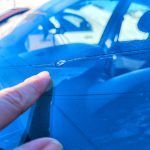While most drivers associate summer with carefree road trips and sunny adventures, the reality is that the season can quietly wreak havoc on your car in ways you might never expect. Beyond the obvious concerns like an overworked air conditioning system or sun-faded paint, summer presents a host of hidden threats that can lead to costly repairs if left unchecked.
From microscopic UV damage that slowly destroys your vehicle’s finish to sudden hailstorms that can leave your car looking like a golf ball, summer’s combination of extreme heat, intense sunlight, and unpredictable weather creates the perfect storm for automotive damage. The key to protecting your investment lies in understanding these risks and taking proactive steps to prevent them.
Let’s explore the surprising ways summer can damage your car—and what you can do about it.
Paint Fade & UV Damage
Your car’s paint job faces a relentless assault every sunny day. The sun’s ultraviolet rays don’t just warm your vehicle’s surface—they actively break down the molecular structure of your paint through a process called oxidation. Over time, this constant exposure causes colors to fade, leaving your once-vibrant vehicle looking dull and weathered.
Darker-colored vehicles bear the brunt of this damage. Black, navy blue, and deep red cars absorb more heat and UV radiation, making them particularly vulnerable to rapid fading and oxidation. The clear coat that protects your paint becomes the first casualty, developing a chalky, hazy appearance that robs your car of its showroom shine.
The damage isn’t just cosmetic—it’s also expensive. Once UV damage sets in, the only real fix is a complete repaint, which can cost thousands of dollars depending on your vehicle’s size and the quality of paint used.
Quick Tip: Regular washing and waxing adds a crucial layer of UV protection. A good coat of wax acts like sunscreen for your car, reflecting harmful rays and preserving your paint’s integrity. Aim to wax your vehicle every three to four months, or consider ceramic coatings for longer-lasting protection.
AC System Overload
When temperatures soar, your air conditioning system works overtime to keep you comfortable. This increased demand during extreme heat can accelerate wear on critical components like the compressor, condenser, and refrigerant lines. What starts as a minor issue in spring can become a complete system failure by mid-summer.
Early warning signs of AC strain include weak airflow from your vents, unusual smells when the system runs, or inconsistent cooling that leaves some areas of your cabin warmer than others. Strange noises, particularly clicking or grinding sounds when you turn on the AC, can indicate compressor problems that will only worsen with continued use.
The refrigerant that keeps your system running can also leak more readily in extreme heat, as seals and gaskets expand and contract with temperature fluctuations. Low refrigerant levels force your compressor to work harder, potentially leading to catastrophic failure.
Preventative Action: Have your AC system inspected early in the season, ideally in late spring before the real heat arrives. A qualified technician can check refrigerant levels, inspect belts and hoses, and identify potential problems before they leave you sweltering in traffic.
Windshield Rock Chips Expanding
That tiny rock chip in your windshield might seem harmless, but summer heat turns it into a ticking time bomb. Glass naturally expands when heated, and even a microscopic crack can quickly spread across your entire windshield when exposed to high temperatures.
The problem becomes exponentially worse when you add sudden temperature changes to the mix. Picture this common scenario: your car sits in blazing sunlight all day, heating the windshield to well over 100 degrees. Then you jump in, blast the air conditioning, and suddenly introduce freezing air to the interior surface. This rapid temperature differential creates stress that can turn a small chip into a spider web of cracks in minutes.
According to Safelite, rock chip damage is 60% more likely to spread during summer conditions compared to cooler months. What might have been a simple $50 repair in spring could become a $300-500 windshield replacement by August.
Callout Tip: Get chips repaired quickly before they become full replacements. Most insurance companies will cover rock chip repairs without a deductible, making it a no-brainer to address these issues immediately. The repair process takes less than 30 minutes and can prevent much more expensive problems down the road.
Tire Pressure Fluctuations
Heat doesn’t just affect your car’s exterior—it also impacts the air inside your tires. For every 10-degree increase in temperature, tire pressure rises by approximately 1-2 PSI. While this might not sound significant, it can push properly inflated tires into the overinflated range, creating several serious problems.
Overinflated tires have less contact with the road surface, reducing traction and making your vehicle more difficult to control, especially in emergency situations. They’re also more susceptible to blowouts, particularly when driving at highway speeds or hitting potholes and road debris.
Conversely, some drivers make the mistake of reducing tire pressure to compensate for heat expansion, which can lead to underinflation once temperatures cool. Underinflated tires create excessive heat buildup through increased rolling resistance, accelerate tread wear, and significantly reduce fuel efficiency.
Tip: Check tire pressure weekly during summer months and inspect tread depth before long drives. Use a quality tire pressure gauge and check your tires when they’re cold—ideally first thing in the morning before driving. Don’t forget your spare tire, which can lose pressure even faster than your main tires.
Battery Strain
While most people associate battery problems with winter cold, summer heat can be equally destructive to your car’s electrical system. High temperatures accelerate the chemical reactions inside your battery, which might sound beneficial but actually leads to faster degradation of internal components.
Heat causes battery fluid to evaporate more quickly, exposing the internal plates and reducing the battery’s ability to hold a charge. The increased chemical activity also promotes corrosion of battery terminals and internal connections, creating resistance that forces your alternator to work harder to keep the battery charged.
Older batteries are particularly vulnerable to heat damage. A battery that might struggle through one more winter could fail completely during a summer heat wave, leaving you stranded in the worst possible conditions.
Preventative Step: Have your battery tested if it’s more than 3 years old, especially before summer’s peak heat arrives. Most auto parts stores offer free battery testing that can identify weak cells or reduced capacity before complete failure occurs. Clean corrosion from terminals regularly and ensure the battery is properly secured to prevent vibration damage.
Interior Damage
Your car’s interior faces a double threat during summer months. Direct sunlight streaming through windows can heat interior surfaces to extreme temperatures—dashboard temperatures can exceed 180 degrees Fahrenheit on hot days. This intense heat, combined with constant UV exposure, creates havoc for synthetic and natural materials alike.
Plastic dashboard components become brittle and crack, while vinyl surfaces fade and develop a sticky texture. Leather seats are particularly vulnerable, as the natural oils that keep leather supple evaporate in extreme heat, leading to cracking and permanent damage. Even fabric upholstery suffers, with colors fading and fibers weakening over time.
The damage often starts subtly—a small crack in the dashboard or slight fading of seat colors—but accelerates rapidly once it begins. UV rays break down the molecular structure of materials, and each day of exposure compounds the problem.
Prevention Tip: Use sunshades and UV-protective treatments on interior surfaces. Dashboard covers, seat protectors, and window tinting can significantly reduce UV exposure and heat buildup. Park in shaded areas whenever possible, and consider using reflective windshield shades that cover the entire windshield rather than small sections.
Hailstorms – The Sudden Threat
Summer storms in Texas and across the Midwest often bring one of the most destructive forces your vehicle can face: hail. Unlike gradual damage from heat and UV exposure, hail strikes with devastating speed and can cause thousands of dollars in damage in just minutes.
Hailstones ranging from pea-sized to golf ball diameter can dent hoods, roofs, and trunk lids, crack windshields and windows, and destroy side mirrors and light assemblies. The irregular shape and varying density of hailstones create unique damage patterns that traditional body repair methods struggle to address effectively.
The unpredictable nature of summer storms makes hail damage particularly frustrating. A car parked outside during what seems like a routine thunderstorm can emerge looking like it went through a war zone, while vehicles just blocks away remain untouched.
Fortunately, modern repair techniques like Paintless Dent Repair (PDR) have revolutionized hail damage restoration. PDR allows skilled technicians to massage dents out from behind damaged panels without affecting the original paint finish, making repairs faster, more cost-effective, and virtually undetectable.
Tip: If possible, use covered parking during storm season. When severe weather threatens, move your vehicle to a garage, covered parking structure, or even under a bridge if necessary. The few minutes spent relocating your car can save thousands in repair costs.
Protecting Your Investment This Summer
Summer’s combination of extreme heat, intense UV radiation, and unpredictable weather creates a perfect storm of potential vehicle damage. From the gradual deterioration caused by constant sun exposure to the sudden devastation of a hailstorm, your car faces threats that can lead to expensive repairs and reduced resale value.
The good news is that most summer-related damage is preventable with proper care and attention. Regular maintenance, protective products, and prompt attention to minor issues can keep your vehicle looking and running like new despite the season’s challenges. Whether it’s applying UV protection to prevent paint damage or getting rock chips repaired before they spread, small investments in prevention pay huge dividends in avoided repair costs.
Smart car care also means being prepared for the unexpected. Understanding your insurance coverage for weather-related damage, knowing reputable repair shops that specialize in techniques like PDR, and having emergency supplies in your vehicle can make the difference between a minor inconvenience and a major disaster.
Before you hit the road this summer, schedule an inspection or hail damage assessment with your local collision center. A professional evaluation can identify existing damage that might worsen in summer conditions and help you develop a maintenance plan that protects your investment year-round. Your car has carried you through countless adventures—make sure it’s ready for many more by giving it the summer protection it deserves.



